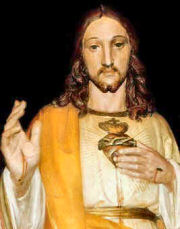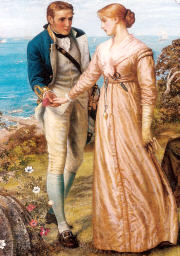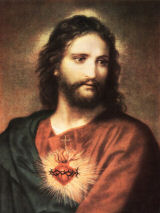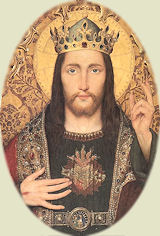June 2025 — Overview for the Month
The beginning of the month of June concludes the liturgical season of Easter, with Pentecost celebrated on June 8. The rest of the month is Ordinary Time, which is represented by the liturgical color green. This symbol of hope is the color of the sprouting seed and arouses in the faithful the hope of reaping the eternal harvest of heaven, especially the hope of a glorious resurrection. It is used in the offices and Masses of Ordinary Time.
The Holy Father's Intentions for the Month of June 2025
That the world might grow in compassion: Let us pray that each one of us might find consolation in a personal relationship with Jesus, and from his Heart, learn to have compassion on the world. (See also Apostleship of Prayer.)
Feasts for June 2025
1. ASCENSION SUNDAY or the SEVENTH SUNDAY OF EASTER, Sunday2. Marcellinus & Peter, Opt. Mem.
3. Charles Lwanga & Companions, Memorial
5. Boniface, Memorial
6. Norbert, Opt. Mem.
8. PENTECOST, Solemnity
9. Blessed Virgin Mary, Mother of the Church; Bernardine of Siena, Opt. Mem.
11. Barnabas; Ember Wednesday, Memorial
13. Anthony of Padua; Ember Friday, Memorial
15. TRINITY SUNDAY, Solemnity
19. Romuald, Opt. Mem.
21. Aloysius Gonzaga, Memorial
22. CORPUS CHRISTI, Solemnity
24. NATIVITY OF ST. JOHN THE BAPTIST, Solemnity
26. Josemaría Escrivá, Opt. Mem.
27. SACRED HEART OF JESUS, Opt. Mem.
28. Immaculate Heart of Mary, Memorial
29. SAINTS PETER AND PAUL, Solemnity
30. First Martyrs of the Holy Roman Church, Opt. Mem.
Focus of the Liturgy
The Gospel readings for June are from St. Luke. All Sunday readings are from Cycle C, and weekday readings are Year I.
June 1 | Cycle C, Lk 24:46-53
|
June 8th | Cycle C, Jn 20:19-23: He breathed on them and said to them, "Receive the Holy Spirit." |
June 15th | Cycle C, Jn 16:12-15: |
June 22nd | Cycle C, Lk 9:11b-17: He woke up, rebuked the wind, and said to the sea, “Quiet! Be still!” The wind ceased and there was great calm. |
June 29th | Cycle C, Mk 5:21-43: He took the child by the hand and said to her, "Talitha koum," which means, "Little girl, I say to you, arise!" The girl, a child of twelve, arose immediately and walked around. |
Highlights of the Month
 As we begin to feel the warmth of summer, we can reflect that we celebrate the feasts of the Ascension (June 1), Pentecost (June 8), Most Holy Trinity (June 15), Corpus Christi (June 22), the Sacred Heart of Jesus (June 27), the Immaculate Heart of Mary (June 28), and Solemnity of Saints Peter and Paul (June 29). God is Love and the Sacred Heart of Jesus — present on earth in the Blessed Sacrament — is the human manifestation of God's Love for men. Appropriately June is considered the month for weddings where human hearts join and cooperate with the Creator in bringing forth new life. The family they create is a human reflection of the Blessed Trinity.
As we begin to feel the warmth of summer, we can reflect that we celebrate the feasts of the Ascension (June 1), Pentecost (June 8), Most Holy Trinity (June 15), Corpus Christi (June 22), the Sacred Heart of Jesus (June 27), the Immaculate Heart of Mary (June 28), and Solemnity of Saints Peter and Paul (June 29). God is Love and the Sacred Heart of Jesus — present on earth in the Blessed Sacrament — is the human manifestation of God's Love for men. Appropriately June is considered the month for weddings where human hearts join and cooperate with the Creator in bringing forth new life. The family they create is a human reflection of the Blessed Trinity.
The saints that we will focus on this month are:
Sts. Marcellinus and Peter (June 2),
St. Charles Lwanga & Companions (June 3),
St. Boniface (June 5),
St. Norbert (June 6),
St. Ephrem (June 9),
St. Barnabas (June 11),
St. Anthony of Padua (June 13),
St. Romuald (June 19),
St. Aloysius Gonzaga (June 21),
the Nativity of St. John the Baptist (June 24),
St. Josemaría Escrivá (June 26),
St. Cyril of Alexandria (June 27),
St. Irenaeus (June 28),
Solemnity of Sts. Peter and Paul (June 29), and the First Martyrs of the Church of Rome (June 30).
The feasts St. Justin (June 1), Sts. John Fisher and Thomas More, and St. Paulinus (June 22) are superseded by the Sunday liturgy.
A Time of Love
 Following Pentecost, the Church begins her slow descent from the great peaks of the Easter Season to the verdant pastures of Ordinary Time, the longest of the liturgical seasons. She pauses briefly, to praise the Holy Trinity — Creator, Redeemer, and Sanctifier; and then the Sacrament of the Body and Blood of Christ, Corpus Christi. Like the lush June growth all around us, the green of the liturgical season points to the new life won for us by the Redemption of Jesus Christ, the new life of Charity. For Our Lord came to cast the fire of His love on the earth, and to that end, sent His Holy Spirit at Pentecost in the form of tongues of fire.
Following Pentecost, the Church begins her slow descent from the great peaks of the Easter Season to the verdant pastures of Ordinary Time, the longest of the liturgical seasons. She pauses briefly, to praise the Holy Trinity — Creator, Redeemer, and Sanctifier; and then the Sacrament of the Body and Blood of Christ, Corpus Christi. Like the lush June growth all around us, the green of the liturgical season points to the new life won for us by the Redemption of Jesus Christ, the new life of Charity. For Our Lord came to cast the fire of His love on the earth, and to that end, sent His Holy Spirit at Pentecost in the form of tongues of fire.
Therefore, the close of the Easter season marks not the cessation but rather the beginning of Ordinary Time is the commencement of the Church’s activity. Ordinary Time is the hour to “go out to all the world and tell the good news.” The feasts of June highlight this expansion of the Church. At least ten times, the Church vests in the red of the martyrs whose blood is the very seed of her growth. She also celebrates the feasts of the Apostles Peter and Paul, and the birth of St. John the Baptist, proto-disciple and prophet.
We, too, are called to be witnesses like the apostles and martyrs. May the Heart of Jesus inflame our hearts so that we may be worthy of our Baptismal call to holiness. Immaculate Heart of Mary, pray for us.
This item 12552 digitally provided courtesy of CatholicCulture.org



 June 13
June 13


 The Archbishop of Mentz established the foundation for Christianity in Germany. His emblem refers to his defense of the Gospel as he met the blow of death while confirming baptized converts.
The Archbishop of Mentz established the foundation for Christianity in Germany. His emblem refers to his defense of the Gospel as he met the blow of death while confirming baptized converts. One of the Apostolic Fathers, whose feast day in olden times was celebrated by young lads and clerks bedecked with roses. This shield is divided.
One of the Apostolic Fathers, whose feast day in olden times was celebrated by young lads and clerks bedecked with roses. This shield is divided. The interwoven symbols of Sts. Peter and Paul are used at Winchester, where the cathedral church is dedicated to these saints.
The interwoven symbols of Sts. Peter and Paul are used at Winchester, where the cathedral church is dedicated to these saints.





